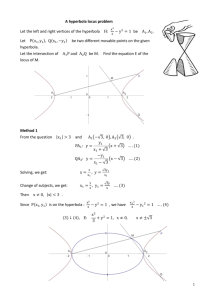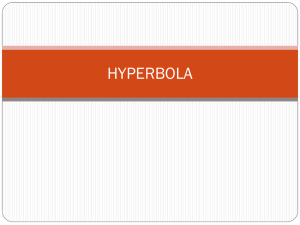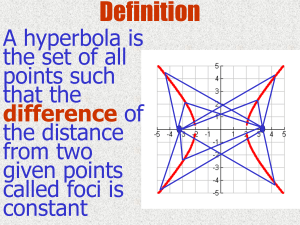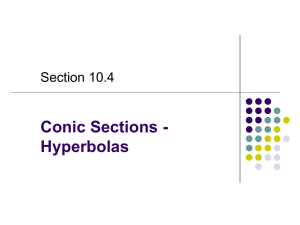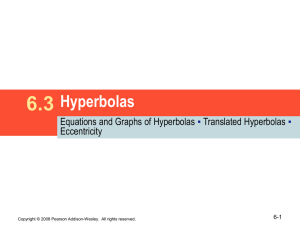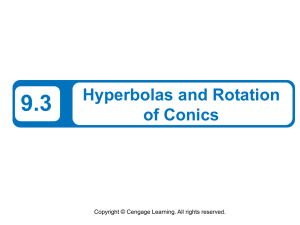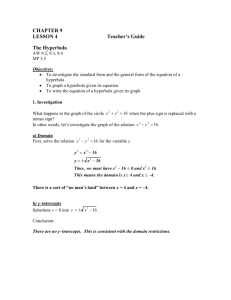2 - WordPress.com
advertisement
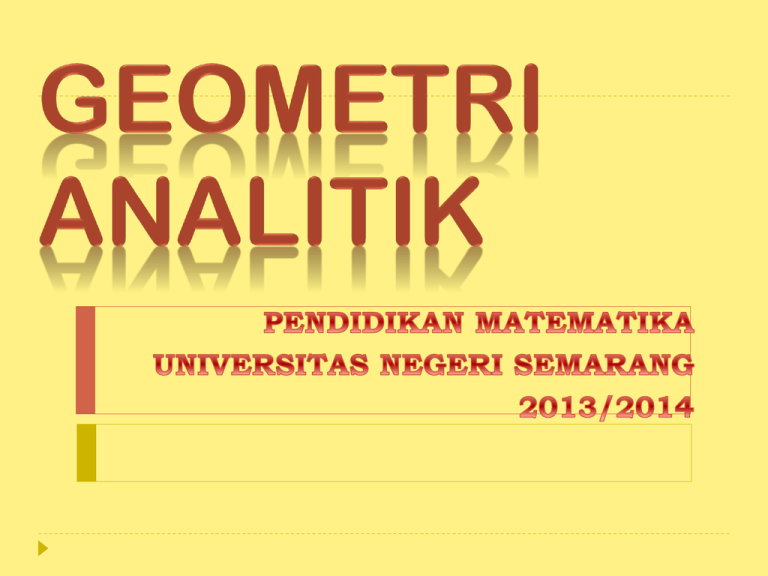
KELOMPOK 6 YUKEVANNY APRILA P (4101412034) HERLINA ULFA NINGRUM (4101412088) DYAN MAYLIA (4101412146) RATNA KARTIKASARI (4101412198) 15. For each equation of acircle : a) Write the equation in standard form b) Specify the coordinates of the center c) Specify the radius d) Sketch the graph The equation is x2 + y2 + 8x – 6y = 0. Answer: x y 8x 6 y 0 2 2 ( x 8 x ...) ( y 6 y ...) 0 2 2 ( x 8 x 16 ) ( y 6 y 9 ) 25 2 2 ( x 4 ) ( y 3) 2 2 25 We know that h= -4 , k= 3, and r = 5. So, the center is at P(-4, 3) and the radius is 5. From the information, we sketch the graph of circle Y’ Y X’ P(-4,3) O’ X O Number 28 16x 2 +25y 2 -64x+100y-236=0 a. Write the equation in standard form b. Specify the coordinates of the center and vertices c. Graph the curve Solution : From the equation we know that, it is an equation of ellipse, because A, C have same signs. 16x2 + 25y2 - 64x + 100y – 236 = 0 16(x2-4x+...) + 25(y2+4y+...) = 236 16(x2-4x+4) + 25(y2+4y+4) =236+ 64 + 100 16(x-2)2 + 25(y+2)2 = 400 ( x 2) 2 ( y 2) 25 2 1 16 So, the coordinates center is P(2,-2) The vertices are Q(-2,-7) and R(-2,-2) To sketch the graph, we write an x’, y’ equation where the origin has been translated to (2,-2) x' 2 25 y' 2 16 1 Graph : y Y’ x P(2,-2) X’ 29. For each equation of an elipse or hyperbola: a) Write the equation in standard form, b) Specify the coordinates of the center and vertices, c) Graph the curve. The equation is 9 x 2 16 y 2 18 x 32 y 151 0 Answer: From the equation hyperbola. 9x 16 y 2 9x 2 2 9 x 16 y 18 x 32 y 151 0 2 2 18 x 32 y 151 0 18 x 16 y 2 32 y 151 9( x 2 2 x ...) 16 ( y 9( x 2 2 x 1 ) 16 ( y 9 ( x 1) ( x 1) we know that, it is an equation from a 2 16 ( y 1 ) 2 ( y 1) 16 2 2 y 1 ) 151 9 16 2 2 2 y ...) 151 144 2 1 9 From the theorem 3.5, we know that: ( x 1) 2 ( y 1) 16 2 We get h=-1 and k=-1, So the center of the hyperbola is P(-1,-1). 1 9 [ x ( 1 )] 16 2 [ y ( 1 )] 9 2 1 In X’Y’ equation, where the origin has been translated to (-1,-1), so the the equation become: x' 2 16 y' 2 1 9 The vertices, lie the X’ axis. Since a2=16 a= ±4 and the vertices are Q(-4,0) and R(4,0) in x’,y’ Or The vertices is A(3,-1) and B(-5,-1) in x,y system. The graph of hyperbola Y Y’ X O Q(-4,0) P(-1,-1) O’ R(4,0) X’ 30. For each equation of an elipse or hyperbola: a) Write the equation in standard form, b) Specify the coordinates of the center and vertices, c) Graph the curve. The equation is x2 – 9y2 + 54y – 90 = 0 Answer: From the equation we know that, it is an equation of hyperbola, because A, C have different signs. x 9 y 54 y 90 0 2 2 x 9 ( y 6 y ...) 90 2 2 x 9 ( y 6 y 9 ) 90 81 2 2 x 9 ( y 3) 2 x 2 9 2 9 ( y 3) 2 1 From the theorem 3.5, we know that: x 2 ( y 3) 2 1 9 We get h= 0 and k= 3, so the center of the hyperbola is at P(0,3). In X’Y’ equation, where the origin has been translated to (0, 3), so the the equation become: x '2 y' 1 2 9 The vertices, lie the X’ axis. Since a2=9 a= ±3 and the vertices are Q(-3,0) and R(3,0). Y Y’ X O(0,0) O’ P(3,0) X’ Number 39 Assuming the graph of each equation exists and is not degenerate,identify its graph using theorem 3.6 4x y x 1 0 2 2 Answer: 2 2 4x y x 1 0 the graph of because A≠C and they have the same sign. is an ellips Number 41 Write an equation a) in standart form and b) in general form of parabola with the given vertex, the focus, or directrix Vertex at (5,6), focus (5,8) Penyelesaian: 2 a )( x h ) 2 p( y k ) 2 ( x 5) 8( y 6 ) b )( x 5 ) 2 8 ( y 6 ) x 2 10 x 8 y 73 0 50. Find a standard equation for a hyperbola satisfying the given condition: Center at (4,6), one vertex at (2,6), one focus at (7,6). Answer: From the center at (4,6) we know that h=4 and k=6 and we translated the hyperbola to (4,6). x’ = x-h x’= 4-4 =0 y’ = y-k y’ = 6-6 =0 So, in X’Y’ system the center is O’(0,0). The vertex in X’Y’ system is: x’ = x-h x’= 2-4 = -2 y’ = y-k y’ = 6-6 = 0 So, in X’Y’ system the verteces are Q(-2,0) and R(2,0). The focus in X’Y’ system is: x’ = x-h x’ = 7-4 = 3 y’ = y-k y’ = 6-6 = 0 So, in X’Y’ system the foci are A(-3,0) and B(3,0). We have one of the vertex is (2,0), so, a=2. We have one of the focus is (3,0), so c= 3 . Now, we will find the value of c. c2=a2+b2 b2=c2 – a2 b2 = 9 – 4 b2 = 5 We can find the equation of the hyperbola in X’Y’ system: x' a 2 2 y' b 2 2 1 x' 2 y' 4 2 1 5 Now, we can find the equation of the hyperbola in X,Y system: we know that x’ = x – 4 and y’ = y – 6. so, the equation is ( x 4) 4 2 ( y 6) 5 2 1 Number 51 Find a standard equation for a hyperbola satisfying the given condition: Vertices at (2,5) and (2,-1), one focus at (2,-4) The center of hyperbola is midpoint of vertices. x x1 k ( x 2 x1 ) x 2 1 (2 2) 2 x 2 y y1 k ( y 2 y1 ) y 1 1 [ 5 ( 1)] 2 y2 so, the center is P(2,2). and we know that h=2 and k=2. a is distance between center and vertex, a ( x 2 x1 ) ( y 2 y 1 ) 2 a 2 ( 2 2 ) ( 2 ( 1)) 2 2 a3 c is distance between center and focus, c ( x 2 x1 ) ( y 2 y 1 ) c c6 2 2 ( 2 2 ) ( 2 ( 4 )) 2 2 Therefore, b 2 = c 2 – a2 = 36 – 9 = 27 The standard form is : ( y 2) 9 2 ( x 2) 27 2 1 Number 54 Write the equations in theorem 3.3a in general form. 2 ( y k ) 2 p( x h) 2 y 2 ky k 2 2 px 2 ph 2 y 2 px 2 ky k 2 2 ph 0 Persamaan tersebut dapat direduksi menjadi 2 Cy Dx Ey F 0 Vertical line of symetry 2 2 p( y k ) (x h) x 2 2 hx h 2 2 py 2 pk x 2 2 hx 2 py h 2 2 pk Persamaan tersebut direduksi menjadi x Dx Ey F 0 2 56. Prove the theorem 3.4 If a ellipse has its center at (h,k), then it has an equation (x h) a 2 b (y k) a (y k) 2 2 2 1 2 (x h) b 2 2 2 1 Proof: From the theorem 2.5, an ellipse has the standard equation x 2 a 2 y 2 b 2 1 If only if its center is the origin and itsfoci are in the x axis. Now, this equation will be translated to (h,k) in X’Y’ system. We know that x = x’+ h x’ = x – h and y = y’ + k y’ = y -k So, the equation become: ( x h) a 2 2 (y k) b 2 2 1 57. Prove the theorem 3.5 If a hyperbola has its center at (h,k), then it has an equation ( x h) a 2 b (y k) a (y k) 2 2 2 1 2 ( x h) b 2 2 2 1 Proof: From the theorem 2.7, a hyperbola has the standard equation x 2 a 2 y 2 b 2 1 If only if its center is the origin and itsfoci are in the x axis. Now, this equation will be translated to (h,k) in X’Y’ system. We know that x = x’+ h x’ = x – h and y = y’ + k y’ = y -k So, the equation become: ( x h) a 2 2 (y k) b 2 2 1
